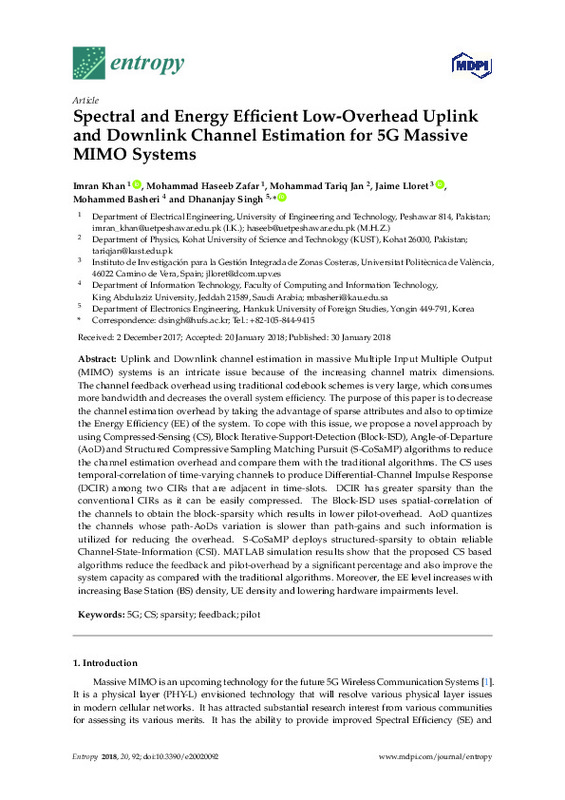JavaScript is disabled for your browser. Some features of this site may not work without it.
Buscar en RiuNet
Listar
Mi cuenta
Estadísticas
Ayuda RiuNet
Admin. UPV
Spectral and Energy Efficient Low-Overhead Uplink and Downlink Channel Estimation for 5G Massive MIMO Systems
Mostrar el registro sencillo del ítem
Ficheros en el ítem
| dc.contributor.author | Khan, Imran
|
es_ES |
| dc.contributor.author | Zafar, Mohammad Haseeb
|
es_ES |
| dc.contributor.author | Jan, Mohammad Tariq
|
es_ES |
| dc.contributor.author | Lloret, Jaime
|
es_ES |
| dc.contributor.author | Basheri, Mohammed
|
es_ES |
| dc.contributor.author | Singh, Dhananjay
|
es_ES |
| dc.date.accessioned | 2019-02-09T21:03:51Z | |
| dc.date.available | 2019-02-09T21:03:51Z | |
| dc.date.issued | 2018 | es_ES |
| dc.identifier.issn | 1099-4300 | es_ES |
| dc.identifier.uri | http://hdl.handle.net/10251/116597 | |
| dc.description.abstract | [EN] Uplink and Downlink channel estimation in massive Multiple Input Multiple Output (MIMO) systems is an intricate issue because of the increasing channel matrix dimensions. The channel feedback overhead using traditional codebook schemes is very large, which consumes more bandwidth and decreases the overall system efficiency. The purpose of this paper is to decrease the channel estimation overhead by taking the advantage of sparse attributes and also to optimize the Energy Efficiency (EE) of the system. To cope with this issue, we propose a novel approach by using Compressed-Sensing (CS), Block Iterative-Support-Detection (Block-ISD), Angle-of-Departure (AoD) and Structured Compressive Sampling Matching Pursuit (S-CoSaMP) algorithms to reduce the channel estimation overhead and compare them with the traditional algorithms. The CS uses temporal-correlation of time-varying channels to produce Differential-Channel Impulse Response (DCIR) among two CIRs that are adjacent in time-slots. DCIR has greater sparsity than the conventional CIRs as it can be easily compressed. The Block-ISD uses spatial-correlation of the channels to obtain the block-sparsity which results in lower pilot-overhead. AoD quantizes the channels whose path-AoDs variation is slower than path-gains and such information is utilized for reducing the overhead. S-CoSaMP deploys structured-sparsity to obtain reliable Channel-State-Information (CSI). MATLAB simulation results show that the proposed CS based algorithms reduce the feedback and pilot-overhead by a significant percentage and also improve the system capacity as compared with the traditional algorithms. Moreover, the EE level increases with increasing Base Station (BS) density, UE density and lowering hardware impairments level. | es_ES |
| dc.description.sponsorship | This research work is supported by Hankuk University of Foreign Studies research fund 2017. | |
| dc.language | Inglés | es_ES |
| dc.publisher | MDPI AG | es_ES |
| dc.relation.ispartof | Entropy | es_ES |
| dc.rights | Reconocimiento (by) | es_ES |
| dc.subject | 5G | es_ES |
| dc.subject | CS | es_ES |
| dc.subject | Sparsity | es_ES |
| dc.subject | Feedback | es_ES |
| dc.subject | Pilot | es_ES |
| dc.subject.classification | INGENIERIA TELEMATICA | es_ES |
| dc.title | Spectral and Energy Efficient Low-Overhead Uplink and Downlink Channel Estimation for 5G Massive MIMO Systems | es_ES |
| dc.type | Artículo | es_ES |
| dc.identifier.doi | 10.3390/e20020092 | es_ES |
| dc.rights.accessRights | Abierto | es_ES |
| dc.contributor.affiliation | Universitat Politècnica de València. Departamento de Comunicaciones - Departament de Comunicacions | es_ES |
| dc.description.bibliographicCitation | Khan, I.; Zafar, MH.; Jan, MT.; Lloret, J.; Basheri, M.; Singh, D. (2018). Spectral and Energy Efficient Low-Overhead Uplink and Downlink Channel Estimation for 5G Massive MIMO Systems. Entropy. 20(2). doi:10.3390/e20020092 | es_ES |
| dc.description.accrualMethod | S | es_ES |
| dc.relation.publisherversion | http://doi.org/10.3390/e20020092 | es_ES |
| dc.type.version | info:eu-repo/semantics/publishedVersion | es_ES |
| dc.description.volume | 20 | es_ES |
| dc.description.issue | 2 | es_ES |
| dc.relation.pasarela | S\376404 | es_ES |
| dc.contributor.funder | Hankuk University of Foreign Studies, Corea del Sur |








